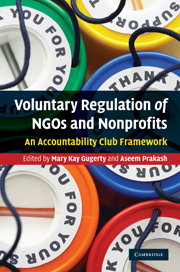Book contents
- Frontmatter
- Contents
- List of figures
- List of tables
- Notes on contributors
- Preface
- The club framework
- Part I Club emergence
- Part II Club sponsorship and club design
- 5 Nonprofit infrastructure associations as reluctant clubs
- 6 Foundation accountability clubs and the search for philanthropic standards
- 7 Do self-regulation clubs work? Some evidence from Europe and some caveats from economic theory
- 8 NGO accountability clubs in the humanitarian sector: social dimensions of club emergence and design
- Part III Club design and effectiveness
- Future research and conclusions
- Index
- References
7 - Do self-regulation clubs work? Some evidence from Europe and some caveats from economic theory
from Part II - Club sponsorship and club design
Published online by Cambridge University Press: 10 November 2010
- Frontmatter
- Contents
- List of figures
- List of tables
- Notes on contributors
- Preface
- The club framework
- Part I Club emergence
- Part II Club sponsorship and club design
- 5 Nonprofit infrastructure associations as reluctant clubs
- 6 Foundation accountability clubs and the search for philanthropic standards
- 7 Do self-regulation clubs work? Some evidence from Europe and some caveats from economic theory
- 8 NGO accountability clubs in the humanitarian sector: social dimensions of club emergence and design
- Part III Club design and effectiveness
- Future research and conclusions
- Index
- References
Summary
We also wanted to make sure there was transparency in the donation system. People must know where their money goes and what it's really spent for.
(Pavlína Kalousová, executive director of the Czech Donors Forum)Quality assurance for goods and services relies often on direct reputations, or indirect reputations provided by ratings systems, certification systems, or self-regulatory programs. (It might also rely on warranties or other more tangible mechanisms.) Ratings systems are involuntary systems established by watchdogs that rate the sellers in a particular market according to some set of criteria or standards. The sellers typically do not take part in the definition of the set of standards, or in the evaluation of their performance in meeting these standards, and thus ratings programs are not voluntary programs. In contrast, various certification systems (e.g., ISO 9000, ISO 14001, Fair Trade coffee, organic certification, or certification systems for charitable organizations) and various self-regulatory programs rely on voluntary participation, at least on the part of those that are certified or take part in such programs. Thus the incentives facing both the designers and the participants in these systems will differ. Complementing our previous work on certification systems (e.g., Ortmann and Svítková, 2007), here we ponder the relative advantages of the competing forms that voluntary participation can take, particularly among nonprofit organizations. Befitting the title of the book to which our chapter contributes, we look at a particular case of a nonprofit accountability club of sorts.
- Type
- Chapter
- Information
- Voluntary Regulation of NGOs and NonprofitsAn Accountability Club Framework, pp. 152 - 168Publisher: Cambridge University PressPrint publication year: 2010
References
- 9
- Cited by



